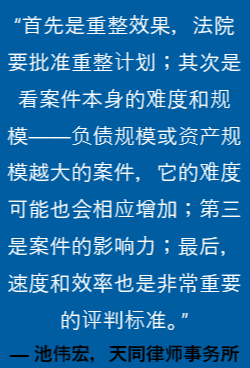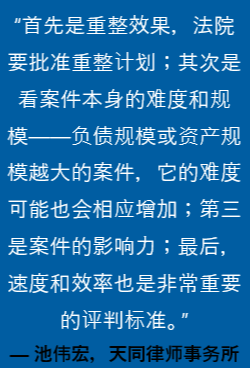
2020年中国债务违约率预计出现上升。2019年底,天物集团12.5亿美元境外债违约,创下20年来国企首例,于此同时,包括中国华信能源、海航集团在内的一系列中国企业也频现违约。截至2019年底,中国企业出现了近200亿美元的债务违约,违约率在2020年将继续维持高点。未来两年,中国企业将有数千亿美元债务到期,而中国政府对于这类违约的救助意愿也在逐渐降低。
中国企业的飞速发展导致了大量债务的产生,随着这些债务的相应到期,企业感受到了前所未有的资金压力。加之中国政府一改以往“ 以救助保就业”的做法,强化以市场化手段规制企业退出制度,反映到法律市场上,则表现为债务重组和破产重整业务的日益增长。
天同律师事务所管理合伙人池伟宏告诉ALB:“在国家政策层面,市场主体退出机制建设遵循市场化、法治化是大趋势。2019年6月发改委、最高法院等13个部委印发的《关于加快完善市场主体退出制度改革方案》也表达了这个核心思想,其中第五部分专门提出了完善国有企业退出机制。”
“从法律层面讲,政府对于陷入债务危机、濒临破产的国企原本就没有法定救助义务。政府对国企的债务违约救助意愿逐渐降低,将其彻底推向市场,其生存、发展、退出完全由市场来决定。”锦天城律师事务所高级合伙人朱林海说,“这正是政府依法治国工作能力的提升,也是优化营商环境,坚持市场化、法治化原则的具体体现。”
同时,其他各参与方也在承担越来越大的责任。“政府希望鼓励,在某些情况下甚至会强迫银行和债权人采取更为积极的行动,包括主动对僵尸企业展开行动。也就是说,银行不能总是延长到期日,继续假装一切都好。政府希望资本能够借此重新流入更为健康的经济市场之中,打造更有效且更受市场规则约束的经济体系。”以上是安理国际律师事务所(Allen & Overy,或简写为A&O)“债务重组和追收业务组”顾问律师郑翠苗(Viola Jing)接受ALB采访时表达的看法。
首当其冲
此轮债务到期和政府态度变化双重压力下首先受到冲击的必然是国有企业。“那些合规管理和风控管理能力比较差的国企,它们一般内部经营管理体制不健全,经营模式落后,风控意识较差,总是依赖政府在政策、经济方面给予扶持。一旦全面市场化,这类企业将因适应市场能力差,最终退出市场。”朱林海律师说。
与此同时,数据表明上市公司的日子也不好过。“2019年有7家上市公司重整,创下了2008年后的历史又一新高。”池伟宏律师说,“此外2019年被申请重整的上市公司达到了14个。在中国企业中,最有偿债能力的就是金融机构和上市公司,如果后者都已经出现大量债券违约、进入破产重整的情况,说明最有偿债能力的板块也承受了较大的债务压力。”
池律师同时指出,这一势头在2020年将延续,“(上市公司重整案例)甚至会比2019年多。因为新《 证券法》将在3月1日实施,其中规定在上市公司符合退市条件时,将不再有暂停上市制度而可能直接终止上市。因此存在债务危机的上市公司会产生更迫切的需求去启动重整。”
连锁效应
这一轮中国企业的债务违约危机也必然引发其他市场主体甚至境外市场的连锁反应。
如果说中国政府在打“僵尸”的同时意图提升其他市场参与者的责任感,这样的努力显然已初现成效。卓文(Ian Chapman)是A&O亚太地区重组业务联席负责人,他告诉ALB:“本所多年以来致力于为大中型中资银行客户提供法律服务,助其应对境内外风险敞口。我们注意到这些银行已开始组建自己的重组团队,增强处理特殊资产的能力,以应对日益严重的违约危机。如何妥善应对违约如同挑战一场日益复杂且艰难的棋局。”
“银行也逐渐通过建立项目监控名单和贷款追踪系统,以尽可能避免被动局面并增强监控。一旦债务人出现信用恶化势头,就可以在其仍存留部分现金、可行业务及若干重组方案的情况下提前介入采取行动。我们现在认为,大多数中资银行客户具备了引导公司走出困境的经验和专门知识。”A&O亚太地区重组业务联席负责人韦国俊(Richard Woodworth)补充说。
随着亚太市场的联系日益紧密,中国企业此波债务重组风潮的影响也绝不仅限于国内。“现在,许多中国大中型企业进入全球市场,选择在新加坡或香港上市。越来越多的中国公司的重组都带有大量境外因素。”韦国俊补充道。郑翠苗则补充说:“随着中国法律和监管环境的发展,境外债权人将有更多机会针对中国境内实体和资产采取直接行动。因此,债权人,无论是国际银行或中资银行,或其境内外分支机构,更有意愿也更便于直接在中国境内采取债务执行行动。”
业务增长
在这样的情况下,律师事务所扮演着怎样的角色?朱林海律师告诉ALB:“在这样的大环境下,包括律师事务所在内的社会中介机构将会发挥更大的作用。”
他以锦天城近期代理的某央企华东公司申请破产一案为例,“该公司因原法定代表人的职务犯罪,以及公司经营管理混乱等原因,导致债台高筑,产生大量诉讼案件。由于受央企国企的保护主义影响,公司股东对公司债务提供担保,也陷入债务泥潭中。我们在华东公司申请破产前,对其资产负债、涉诉情况进行了全面梳理;通过司法审计否定了公司股东和法人人格混同,通过刑事追赃尽可能多地追回资产。为了在华东公司进入破产程序后,所有债权人可以实现更多的债权,也为了华东公司可以合法高效地退出市场。这证明了法律服务机构可以发挥更大作用。”
而在业务数量上,朱律师指出:“自2018年下半年至今,破产重整及清算业务量经历了不断上涨。”
A&O债务重组团队也认可这样的结论。韦国俊认为:‘’由于现在的政策偏向更有利于市场规则发挥作用并允许企业债务违约,违约现象只会越来越多。”
在这种背景下,如何把法律服务做好,不同律所也采取了不同策略。“在亚洲,我们仍然经常看到债务重组业务被视为诉讼业务,A&O则将这项业务定位于提供全方位法律服务。我们的团队理念是:呈现给客户常驻亚洲的专业重组律师团队,以诉讼实力为核心,精通银行与金融业务,更了解客户并购交易的方方面面。因此A&O团队是一支独一无二的、拥有扎实中文能力和综合业务实力的一体化专业团队。A&O这种具备综合服务技能的律师团队正是该行业内各参与方的不二之选。”韦国俊继续表示。
郑翠苗补充道:“如韦律师所言,在亚太地区,多数客户认为在危机发生前很难就重组话题展开对话,所以客户希望律师提供执行和诉讼方面的建议,以便促使企业与其开展重组对话。客户希望的不仅仅是破产诉讼或交易重组的专业能力,而是希望像我们这样具备综合法律技能,能够在跨境环境下从容应对各种挑战的法律团队。”
 池伟宏律师将破产重整案例是否成功的判断因素分为四点:“ 首先是重整效果,法院要批准重整计划;其次是看案件本身的难度和规模——负债规模或资产规模越大的案件,它的难度可能也会相应增加;第三是案件的影响力;最后,速度和效率也是非常重要的评判标准。”
池伟宏律师将破产重整案例是否成功的判断因素分为四点:“ 首先是重整效果,法院要批准重整计划;其次是看案件本身的难度和规模——负债规模或资产规模越大的案件,它的难度可能也会相应增加;第三是案件的影响力;最后,速度和效率也是非常重要的评判标准。”
他以天同近期作为管理人办理的上市公司庞大集团重整案为例:实践中一个企业重整案在中国通常需要11个月左右完成,但庞大集团重整案从立案受理到法院批准重整计划,仅用了95天。在复杂性上,庞大集团负债规模达247亿,涉及164家金融机构的谈判,涉及子分公司资产上千个,涉及股民33万人,同时由于庞大集团是“汽贸上市第一股”,连续11年跻身“中国企业500强”,可见庞大集团是具有全国影响力的行业龙头企业,在这么有压力的案例里做到短时间内结案,也是效果好的表现”。
增值服务
在中国企业债务违约频现的情况下,律所也希望以其他方式提供增值服务,最典型的方法就是通过协调债权人和企业尽早展开对话,避免灾难性后果的发生。
韦国俊告诉ALB,他们确实代表过不少提前介入的案例,在这些案例中债权人主动敦促债务企业采取行动。他详述了A&O曾代表的一宗案例,“该案例涉及一家知名中国企业集团,债权人发现该集团有可能会陷入财务困境,因此迅速组织成立债权人委员会,以负责安排相关事宜,对债务企业施压并敦促债务企业与债权人委员会合作寻求解决方案。最终成功使债务人从多个贷款人处获得再融资,贷款人也同意不终止借贷关系。”
但他也同时指出:“中国内地和香港存在一个重要难点,当债务企业拒绝配合承认和解决现有问题时,债权人要协调规划出解决方案就会极其困难。在其他国家和地区,未及时寻求协助的董事会成员将可能面临潜在的法律义务,因而更容易尽早发现公司问题,但中国内地和香港目前这方面的立法较弱。这意味着,董事们能够一直将公司问题拖延下去,而银行只有在爆点后才能真正参与进来。”
卓文同意韦国俊的上述观点,他表示“董事需要承担更多的责任”,但他同时也提出:“我们也应采取更为谨慎的态度,法律环境不能过度严苛,否则会遏制企业家精神,亚洲国家不断发展和创新的动力正是源自于这种精神。因此需要在这两者之间把握好平衡。”
与此同时,跨境因素也正推动着法律制度进一步发展。卓文表示:“跨境破产案件最终将把全球各体系引向一体化。例如,我们看到,尤其在中国内地和香港之间,不同法律制度下司法协助日趋密切。中国内地承认香港仲裁裁决,还可以协助在内地执行财产保全措施和其他类似措施。中国政府正在大力促进司法体系之间的融合,这是令人鼓舞的发展。经济的发展必将驱动法律体系的变化。”
着眼于取得建设性成果,A&O将该业务组命名为“债务重组和追收业务组”。“债务重组和追收是我们期望的目标,因此我们在业务名称上采用同义词叠用的方式,但我们的首要目标是恢复企业运营、保护就业、在保留企业的前提下为所有相关利益者争取最好的结果。”卓文说,“说来讽刺,最好的重组应该是你在市场上从来没听说过的那类重组。”
预期未来
三家受访律所都表示:预期在未来的一到两年中,债务重组业务会稳步增加,他们也都准备好了扩充队伍。
天同计划在两三年内将破产重组团队扩大到40人以上,池伟宏律师同时指出:“随着《破产法》的普及,客户对于破产律师的专业要求越来越高,特别是对管理人的要求会更高,现在市场上也频现起诉管理人违法履行责任的案例;此外,对破产律师的资源整合及协调能力也提出了更高要求,破产律师需要充分了解债权人诉求,提供可行的解决方案。”
锦天城也在不断增强这方面的实力。朱林海律师告诉ALB,锦天城上海总部是上海高院指定的10家企业破产案件一级管理人之一,此外,律所在全国还有十五家分所具有破产管理人资格。他们还在所内成立了破产重整与清算专业委员会,由朱律师担任总召集人,统筹全国三百多位从事破产业务的执业律师等人员,并计划在未来两年内继续扩大团队。
A&O正不断在亚洲大力发展重组业务能力。“我们以香港办公室为中心,在新加坡和雅加达也配备专业团队。我们在今年年初获得了上海市司法局的批准,在上海自贸区内与上海朗悦律师事务所展开联营。通过联营,我们可以向客户提供中国法律服务。过去12个月,我们亚洲地区的团队规模扩展了一倍。”卓文说道。
“本所上海办公室合伙人姜颖律师是国际破产协会亚洲区总部创始会员,国际破产协会亚洲区总部致力于促进亚洲地区的发展和破产领域的跨境协作。但是此前我们因为无法在中国法下从事诉讼业务,也感受到了限制,和朗悦的联营恰好补齐了这一缺口。现在我们能够提供全方位的服务,可以为客户处理债务重组和追收项目涉及的所有事务。”韦国俊补充道。
国有债务人激怒投资者
【路透社】青海省投资集团有限公司的三支美元债面临重整,而其重整计划激怒了债券持有者。
最近,由青海省政府控制的青海省投资集团下属子公司提出以极大折扣购买其价值8.5亿美元的债券。
青海省投下属的这家离岸子公司国臻国际贸易有限公司提出以3亿美元价格购买青海省投将于2020年到期的债券——此价格仅为发行价的41.19%。此外,国臻国际还提议以5.5亿美元购买另外两支将于2021年到期的债券,此价格为发行价的36.75%。
青海省投表示,如果投资者不接受此邀约,他们拿回投资的机会就很渺茫,因为发行人“正陷于困难的运转境地之中”,对于偿还债券没有信心。
“这就是诈骗。是套利。这么做太邪恶,也太不知羞耻了。”一位愤怒的投资人在持有人电话会议上大发脾气。后来他的通话被强行切断了。
另一位投资人也提出了同样质疑,认为这项邀约存在利益冲突,“充满恶意”。
“重整的整个设计都是为了套利。”该投资人告诉青海省投的经理,“你们在用金融手段谎骗投资人。这是在破坏资本市场交易秩序。”
持有人会议组织者拒绝直接回答问题。他仅仅指出两家公司不存在关联,青海省投作为发行人已经面临资金短缺。会议随后匆匆结束。
2019年11月,天物集团也曾提出以类似方式重整其无力偿还的债券。
Fighting Zombies
As of 2019, Chinese companies had defaulted on nearly $20 billion in loans, and the country’s default rate is expected to grow further. In the next two years, companies will owe hundreds of billions of dollars in debt that is coming due, with the government also less willing to provide support for such defaults. Lawyers say that China needs to take a balanced approach towards its insolvency and restructuring landscape.
The rapid growth of Chinese companies has led to a surge in borrowing, and companies are under unprecedented financial pressure as the debt is coming due. For example, in late 2019, Tewoo Group Corp failed to repay its $1.25 billion offshore bond, marking the first offshore default by a state-owned enterprise (SOE) in 20 years. The country also saw more defaults by Chinese companies such as CEFC China Energy and HNA Group.
The Chinese government has also changed its practice of “providing support to secure employment” and strengthened market-based measures to regulate the exit mechanism for the companies. “At the national policy level, it is a general trend that the exit mechanism for market entities will follow marketization and rule of law. The ‘Reform Plan on Improving the Exit Mechanism for Market Entities’ issued by 13 agencies including the National Development and Reform Commission and the Supreme People’s Court in July 2019 also reflected this core idea. The fifth portion of the plan mentioned the improvement of the exit mechanism for SOEs,” says Chi Weihong, managing partner at Tiantong & Partners.
“From a legal perspective, the government is never obliged to subsidize SOEs that are facing huge debt or bankruptcy. The government is less willing to help these SOEs for their defaults and is pushing them to the market to let it determine their survival, development or withdrawal,” says Zhu Linhai, senior partner at Allbright Law Offices. “This points to the improvement of the government’s ability to rule the country following the law. It is also an example of optimizing the business environment and adhering to the principles of marketization and rule of law.”
On the other hand, the government intends to make other market entities take more responsibilities. “The government is encouraging and, in some cases, effectively forcing banks and creditors to take more proactive actions, such as to deal with zombie companies. What it means is that banks can no longer extend the maturity date and then continue as if nothing has happened. The rationale behind this is to recycle capital back into a positive economy, and to move towards building a functioning system with more market discipline,” Viola Jing, of counsel in Allen & Overy’s Asian Restructuring & Recovery Group shares with ALB.
THE FIRST TO BE HIT
The dual pressures of debt maturity and changes in government attitudes will inevitably hit the SOEs first. “The SOEs with poor compliance and risk management usually have an ill-founded internal management system, a backward business model, and poor awareness of risk control. They always rely on support from government policies and subsidies. Once the market takes over, these enter-prises will exit the market as they cannot cope well,” Zhu says.
Meanwhile, data shows that listed companies are also struggling. “In 2019, seven listed companies underwent restructuring, hitting another record after 2008,” Chi says. “In addition, nearly 50 listed companies filed for restructuring. Among the Chinese companies, financial institutions and listed companies have the best capability to pay their debts. If many of the listed companies are seeing defaults, entering bankruptcy, and restructuring, it shows that even the most capable companies have exceeded their limits.”
He also noted that this trend is likely to continue in 2020. “More listed companies will undergo restructuring compared to 2019. The new Securities Law, which will come into effect on March 1, stipulates that when a listed company meets the delisting conditions, there will be no longer be a suspension of listing and the company will delist directly. Therefore, listed companies with a debt crisis will have a more urgent need to initiate restructuring,” he adds.
RIPPLE EFFECTS
This round of default crisis of the Chinese companies is also poised to create ripple effects for other market entities and even overseas markets.
If the Chinese government intends to increase the sense of responsibility of other market players while fighting the zombie companies, these efforts are paying off. Ian Chapman, co-head of Allen & Overy’s Asian restructuring practice tells ALB: “We have been very focused on the major PRC banks for a number of years, in respect of their onshore as well as offshore exposures, and we have noted that they are responding to the increasing levels of default by building up their workout teams, building up a special asset expertise. It’s an increasingly sophisticated game being played on how these things should be run.”
“Banks are also increasingly seeing the need to be less reactive and to monitor situations as they develop data-bases with watchlists and trackers. This allows them to follow their credit portfolios and track when credits start to deteriorate intending to step in and act when there is still some cash and viable business and still a few more options available to restructure. We’d now say that well over a majority of our Chinese banking clients have experi-ence and know how to guide companies through the situations,” adds Richard Woodworth, fellow practice co-head.
As the Asia-Pacific markets become increasingly interlinked, the impact of this wave of debt restructuring by Chinese companies is not only an issue for domestic market. “We’ve seen the emergence into the global markets of a large number of major Chinese corporates. They’ve got Singapore listings, they got Hong Kong listings. More and more Chinese restructurings now have a very significant offshore element,” Woodworth says. “The development of the legal and regulatory environment in China now gives offshore creditors more opportunities to take direct action against PRC entities and assets. Creditors, whether international banks or PRC banks, onshore or offshore branches, are now more willing and prepared to take direct enforcement action within the PRC,” Jing adds.
LEGAL WORK GROWING
For law firms, this scenario means more restructuring work; it also meant that they are playing a wider role. Zhu cites a case handled by Allbright on behalf of an East China SOE as an example. “The company’s debt ran high as the original legal representative was derelict in his duty and the management was disorganized, which led to a large number of lawsuits. Due to protectionism for SOEs, the shareholders provided guarantees for the company’s debt and fell into heavy debt themselves. Before the East China company filed for bankruptcy, we took a comprehensive look at its assets, liabilities, and litigation,” he says.
“We sought reverse piercing of the corporate veil through judicial auditing, and we tried to recover as many assets as possible through criminal recovery of stolen property,” Zhu adds. “These efforts helped all creditors credit bid their claims after the company moved into bankruptcy proceedings, and the company was able to exit the market legally and efficiently. This demonstrates that legal service providers can play a bigger role,” he says.
In terms of legal work, Zhu says the number of bankruptcy restructuring and liquidation cases has been on a rise since the second half of 2018.
Allen & Overy’s restructuring practice team draw the same conclusion. “And now that there has been this policy shift towards market discipline and allowing defaults, the number of defaults is only going to keep increasing,” Woodworth comments.
Law firms have adopted different strategies to improve their services against this backdrop. “In Asia, it’s still quite often seen as more of a litigation practice. Whereas what we think is it’s a far more holistic practice. The philosophy of our team is that our clients expect Asian based specialist restructuring lawyers like ours who not only understand banking and finance, but also know their way around M&A. Even so, litigation capabilities are essential which is why our team uniquely is an integrated team, and one with a real depth of Chinese language skills – I think you need all these combined skills if you are looking to find the best solution for all stakeholders,” Woodworth continues.
Jing of Allen & Overy notes: “Building on Richard’s comments, in this region, most of our clients accept that it is not easy to engage in a restructuring discussion before a crisis occurs and so they expect advice on enforcement and litigation strategies to push the company to engage in restructuring discussions with them. The client’s expectation is no longer just insolvency litigation expertise or transactional rescheduling or re-papering expertise, but for a team like ours which offers a combined skill set to deal with all of the challenges in a cross-border scenario.”
 Chi suggests four criteria to test if a restructuring case is successful. “The first is the outcome, as the court has to approve the restructuring plan. Second is the complexity and the scale of the case. The larger the debt amount or asset size is, the more complex the case is. Third is the influence of the case. Lastly, speed and efficiency are also important considerations,” he says.
Chi suggests four criteria to test if a restructuring case is successful. “The first is the outcome, as the court has to approve the restructuring plan. Second is the complexity and the scale of the case. The larger the debt amount or asset size is, the more complex the case is. Third is the influence of the case. Lastly, speed and efficiency are also important considerations,” he says.
He cites the restructuring that Tiantong handled on behalf of listed company Pangda Automobile Trading Co. Ltd. as an example. It generally takes 11 months to complete restructuring in China, but it took only 95 days for the case to be established and approved by the court. In terms of complexity, Pangda’s debt amounted to 24.7 billion yuan, involving negotiations with 164 financial institutions. The group also had around a thousand subsidiaries and 300,000 shareholders. “To be able to close a case under such enormous pres-sure in a short time is a good outcome,” he says.
ADDING VALUE
As more Chinese companies default, law firms hope to provide value-added services in other ways. The most typical is to initiate a dialogue between creditors and the company as early as possible to avoid catastrophic consequences.
Woodworth tells ALB that they have a number of deals where the creditors have been very active in pushing the company for engagement. He shares one example: “There was a fairly high profile Chinese conglomerate and the creditors spotted that the group was likely heading towards difficulties and quickly got organized with a creditors’ committee. They took leadership, put pressure on the debtor group to engage and to work with the committee to find a solution. As a result, they were able to get to a position where the debtor was able to successfully refinance their liabilities with a number of the lenders being comfort-able to continue with the relationship.”
But he also points out: “But one of the key challenges in Mainland China like in Hong Kong is that it can be pretty hard for a creditor to work collaboratively to find solutions, unless the company is willing to engage and recognize it has a problem. In other jurisdictions around the world, there is greater ease to get the problem addressed earlier if there are potential personal liabilities for directors who fail to seek help. At the moment, both Mainland China and Hong Kong are very lenient in this area, which means directors more often than not carry on too far and too long and the banks can only get involved when they’re already at crisis point.”
While agreeing with Woodworth’s observation, Ian Chapman also has a different take on this:” I agree a much higher level of accountability of directors is needed, but I think we also have to be very careful not to get to an over-regulated situation which then stifles the entrepreneurial spirit, which is the engine of growth and innovation in Asia. And it’s a fine balance.”
On the other hand, cross-border factors are driving the development of the legal system. “The ultimate objective of cross-border insolvency is to have a global system. Specifically in Hong Kong and the Mainland, we are seeing increasing judicial collaboration in terms of our systems meshing with cross recognition. You’re seeing Hong Kong arbitration recognition and how this assists on the Mainland in terms of asset preservation orders and the like. And we are seeing very encouraging developments in terms of how the Mainland is in a way driving it. Economics will drive the system,” says Chapman.
With a focus on getting positive results, Allen & Overy calls this practice its Restructuring and Recovery Group, “because that’s what our goal is. It’s a double play on words, but our primary goal is to rehabilitate, to save jobs, and to get the best result for all stakeholders, without destroying businesses. Ironically, the best recoveries are the ones that the market never hears about,” says Chapman.
LOOKING AHEAD
Tiantong, Allbright and Allen & Overy all say that they are ready to expand their teams in expectations of a steady increase in restructuring business over the next one to two years.
Tiantong plans to expand its restructuring team to 40 members. “As the Bankruptcy Law is applied, the professional requirements for bankruptcy lawyers will increase, especially for administrators. We are also seeing more cases in which the administrators are sued for default in the performance. In addition, bankruptcy lawyers are required to integrate resources and coordinate better. They need to fully understand what the creditors need to provide a solution,” Chi says.
Allbright is also enhancing its competitiveness. Zhu tells ALB that the law firm’s headquarters in Shanghai is one of the first-tier administrators designated by Shanghai High People’s Court to handle corporate bankruptcy cases. Fifteen offices of the law firm are qualified as bankruptcy administrators. Allbright has also established a bankruptcy restructuring and liquidation committee convened by Zhu that manages over 300 bankruptcy legal professionals, and it plans to expand its team in the next two years.
Allen & Overy continues to build its restructuring strengths in Asia. “We have a hub in Hong Kong. We have dedicated resources in Singapore and Jakarta, and at the beginning of this year, we have announced our joint operation with Shanghai Lang Yue Law Firm, as approved by the Shanghai Bureau of Justice. Through this Joint Operation, we can offer our clients service in relation to PRC law. Over the past 12 months our regional restructuring team has doubled in size,” says Chapman.
“Jane Jiang, a partner in our Shanghai office is a founder member of the INSOL Asia committee driving regional development and cross border cooperation in the insolvency space. But there were limitations on the client service that we could offer. In particular, Allen & Overy cannot litigate for clients. In contrast, Allen & Overy working together with Lang Yue will give the clients the full service that they need across all aspects of restructuring and recovery matters,” Woodworth adds.
State-owned borrower infuriates investors with sharp haircuts
(Reuters) - An attempt to restructure three-dollar bonds by China’s Qinghai Provincial Investment Group that will pay bondholders only 40 cents on the dollar is “wickedly designed,” investors have said.
Recently, a subsidiary of Qinghai Provincial Investment and Development Co - which, like QPIG, is controlled by Qinghai’s local government - proposed buying the $850 million worth of bonds at a sharp discount.
Guozhen International Trade Consulting, a unit of QPID, offered to buy $300 million of QPIG bonds due 2020 at 41.19 percent of face value. In addition, Guozhen offered to buy two batches of bonds due 2021 worth a total of $550 million at 36.75 percent of face value.
Du Ying, director of QPID, said on a conference call that if bond investors chose not to accept the offer, their chances of getting money back were slim, because the issuer “is in a difficult operational situation” and the bonds are unsecured.
“This is cheating. This is arbitrage. This practice is extremely wicked, and shameless,” an enraged investor said during the conference call. His call was cut off by the operator.
Another investor raised the same issue, saying the offer involves conflicts of interest, and is “wickedly structured.”
“The whole structure is an act of arbitrage. You’re definitely not a white knight. You’re a black knight,” the investor told the QPID managers. “You’re using financial tricks to harm bond investors. This is damaging capital markets order.”
Du declined to answer the questions directly. He said only that the two companies were unrelated and that QPIG, the bond issuer, is struggling and suffering from liquidity shortage. The conference call was cut short.
The tender offer for QPIG bonds follows the pattern of debt restructuring of another state-owned company, Tewoo Group, in late November.
To contact the editorial team, please email ALBEditor@thomsonreuters.com.





